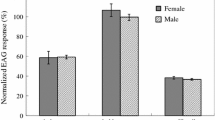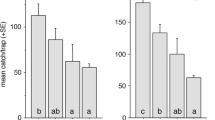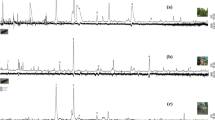Abstract
The absorption and release of the pheromone ofEpiphyas postvititana (Lepidoptera: Tortricidae),E 11–14: OAc andE,E 9, 11–14: OAc (95:5) by apple leaves was studied using electroantennograms (EAG) and sticky traps baited with pheromone-treated leaves. Leaves exposed to an airstream containing pheromone reached a constant level of pheromone release within 3 min. Release occurred over a period greater than 24 hr, following removal of leaves from the pheromone-saturated environment. Pheromone-treated leaves were effective as lures in sticky traps for at least three nights, although the average catch per night decrease logarithmically with time. In the field, pheromone was detected by EAG on leaves harvested from up to 25 cm away from a central point source of pheromone. The shape of a surface representing equal pheromone re-release from leaves around a central point source was defined by interpolation from a three-dimensional transect. Leaves harvested from 5 cm under the dispensers showed the highest pheromone release rate. Leaves downwind of the dispensers also had higher release of pheromone. In a treated orchard, significantly higher EAG measurements were recorded in the rows of trees that contained dispensers, compared to grass interrows or untreated trees. The implications of foliar pheromone adsorption and release on atmospheric concentrations and insect behavior require further investigation.
Similar content being viewed by others
References
Baker, A.E. 1982. Chemistry and morphology of plant epicuticular waxes, pp. 139–165,in D.F. Cutler, K.L. Alvin, and E. Price (eds.). The Plant Cuticle. Academic Press, London.
Baker, T.C., andHaynes, K.F. 1989. Field and laboratory electroantennographic measurements of pheromone plume structure correlated with oriental fruit moth behavior.Physiol. Entomol. 14:1–12.
Baker, T.C., Willis, M.A., Haynes, K.F., andPhelan, P.L., 1985. a pulsed cloud of sex pheromones elicits upwind flight in male moths.Physiol. Entomol. 10:257–265.
Baker, T.C., Hansson, B.S., Löfstedt, C., andLöfqvist, J. 1988. Adaptation of antennal neurons in moths is associated with cessation of pheromone-mediated upwind flight.Proc. Natl. Acad. Sci. U.S.A. 85:9826–9830.
Bartell, R.J. 1982. Mechanisms of communication disruption by pheromones in the control of Lepidoptera: A review.Physiol. Entomol. 7:353–364.
Bartell, R.J., andLawrence, L.A. 1973. Reduction of responsiveness ofEpiphyas postvittana (Lepidoptera) to sex pheromone following previous brief pheromonal exposure.J. Insect Physiol. 19:845–855.
Bellas, T.E., Bartell, R.J., andHill, A. 1983. Identification of the two components of the sex pheromone of the moth,Epiphyas postvittana (Lepidoptera, Tortricidae).J. Chem. Ecol. 9:503–512.
Bengtsson, M., Karg, G., Kirsch, P.A., Löfqvist, J. Sauer, A.E., andWitzgall, P. 1994. Mating disruption of the pea mothCydia nigricana F. (Lepidoptera, Tortricidae) with a repellent blend of sex pheromone and attraction inhibitors.J. Chem. Ecol. 20:871–887.
Bossert, W.H., andWilson, E.O. 1963. The analysis of olfactory communication among animals.J. Theor. Biol. 5:443–469.
Cardé, T.C. 1990. Principles of mating disruption, pp. 42–71,in R.L. Ridgeway, R.M. Silverstein, and M.N. Insche (eds.). Behavior-Modifying Chemicals for Insect Management. Dekker, New York.
Den Otter, C.J., Schuil, H.A., andSander-Van Oosten, A. 1978. Reception of host-plant odours and female sex pheromone inAdoxophyes orana (Lepidoptera: Torticidae): Electrophysiology and morphology.Entomol. Exp. Appl. 24:370–378.
Dunn, J.S., andStolp, M. 1987. Apples on the Lincoln canopy: Mechanized management.HortScience 22:568–572.
Fernandes, A.M.S., Batt, R.F., andMartin, J.T. 1964. The cuticular waxes of apples leaves and fruit and the cuticles of pear fruits during growth. Report of Long Ashton Research Station for 1963, University of Bristol.
Jeffree, C.E. 1986. The cuticle, epicuticular waxes and trichomes of plants, with reference to their structure, function and evolution, pp. 23–64in B.E. Juniper and T.R.E. Southwood (eds.). Insects and the Plant Surfaces. Edward Arnold, London.
Jutsum, A.R., andGordon, R.F.S. (eds.). 1989. Insect Pheromones in Plant Protection. Wiley, New York.
Karg, G., Sauer, A.E., andKoch, U.T. 1990. The influence of plants on the development of pheromone atmospheres measured by EAG method, p. 301,in N. Elsner and G. Roth (eds.). Brain-Perception-Cognition. Proceedings of the 18th Göttingen Neurobiology Conference. Thieme Verlag, Stuttgart.
Kennedy, J.S. 1978. The concept of olfactory “arrestment” and “attraction.”Physiol. Entomol. 3:91–98.
Kennedy, J.S. 1982. Mechanisms of moth sex attraction: A modified view based on wind tunnel experiments with flying Axoxophes.colloq. INRA 7:184–192.
Kennedy, J.S., Ludlow, A.R., andSanders, C.J. 1980. Guidance system used in moths sex attraction.Nature 288;475–477.
Kennedy, J.S., Ludlow, A.R., andSanders, C.J. 1981. Guidance of flying male moths by wind-borne sex pheromone.Physiol. Entomol. 6:109.120.
Murlis, J. 1986. The structure of odour plumes, pp. 27–38,in T.L. Payne, M.C. Birch, and C.E.J. Kennedy (eds.). Mechanisms on Insect Olfaction. Oxford University Press, Oxford, U.K.
Murlis, J., andJones, C.D. 1981. Fine-scale structure of odour plumes in relation to insect orientation to distant pheromone and other attractant sources.Physiol. Entomol. 6:71–86.
Murlis, J., Elkinton, J.S., andCardé, R.T. 1992. Odor plumes and how insects use them.Annu. Rev. Entomol. 37:505–532.
Noldus, L.P.J.J., Potting, R.P.J., andBarendregt, H.E. 1991. Moth sex pheromone adsorption to leaf surfaces: Bridge in time for chemical spies.Physiol. Entomol. 16:329–344.
Ridgeway, R.L., Silverstein, R.M., andInscoe, M.N. (eds.). 1990. Behavior-Modifying Chemicals for Insect Management: Applications of Pheromones and Other Attractants, Marcel Dekker, New York.
Roelofs, W.L. 1978. Threshold hypothesis for pheromone perception.J. Chem. Ecol. 4:685–699.
Rumbo, E.R. 1981. Study of the single sensillum responses to pheromone in the light brown apple moth,Epiphyas postvittana, using the averaging technique.Physiol. Entomol. 6:87–98.
Rumbo, E.R., Deacon, S.M., andRegan, L.P. 1993. Spatial discrimination between natural pheromone and inhibitor in the light-brown apple mothEpiphyas postvittana (Walker) (Lepidoptera: Tortricidae).J. Chem. Ecol. 19:953–962.
Sauer, A.E. 1991. Bestimmung von Pheromonkonzentrationen im Freiland mit Elektroantennogrammen zur Unterstützung der Paarungsstörmethode bei den TraubenwicklerartenLobesia botrana undEupocelia ambiguella. PhD thesis. University of Kaiserslautern, Germany.
Sauer, A.E., Karg, G., Koch, U.T., De Kramer, J.J., Milli, R. 1992. A portable system for the measurement of pheromone concentrations in the field.Chem. Senses 17:543–588.
Suckling, D.M. 1993. Sex pheromones: Are they delivering to expectations: pp. 62–65,in S.A. Corey, D.J. Dall, and W.M. Milne (eds.). Pest Control and Sustainable Agriculture. CSIRO, Canberra.
Suckling, D.M. andClearwater, J.R. 1990. Small scale trials of disruption ofEpiphyas post-vittana (Lepidoptera: Tortricidae) in New Zealand.Environ. Entomol. 19:1702–1709.
Suckling, D.M., andShaw, P.W. 1990. Preliminary trails of mating disruption of lightbrown apple moth in Nelson.Proc. 43rd N.Z. Weed and Pest Control Conf. 1990:311–316.
Suckling, D.M., andShaw, P.W. 1991. Evaluation of mating disruption of lightbrown apple moth in Nelson.Proc. 44rd N.Z. Weed and Pest Control Conf. 1991:47–51.
Suckling, D.M., andShaw, P.W. 1992. Conditions that favour mating disruption ofEpiphyas postvittana (Lepidoptera: Tortricidae).Environ. Entomol. 21:949–956.
Suckling, D.M., Shaw, P.W., Khoo, J.G.I., andCruickshank, V. 1990. Resistance management ofEpiphyas postvittana (Lepidoptera: Tortricidae) using mating disruption.N.Z. J. Crop Hortic. Sci. 18:89–98.
Suckling, D.M., Karg, G., Bradley, S.J., andHoward, C.R. (1994). Electroantennogram and behavioral responses ofEpiphyas postvittana under low pheromone concentrations.Environ. Entomol. In Press.
Wall, C., Sturgeon, D.M., Greenway, A.R., andPerry, J.N. 1981. Contamination of vegetation with synthetic sex attractant released from traps for the pea moths,Cydia nigricana.Entomol. Exp. Appl. 30:111–115.
Willis, M.A., andBaker, T.C. 1984. Effects of intermittent and continuous pheromone stimulation on the flight behaviour of the oriental fruit moth,Grapholita molesta.Physiol. Entomol. 9:341–358.
Wilson, E.O., Bossert, W.H., andReigner, F.E. 1969. A general method for estimating threshold concentrations of odourants.J. Insect Physiol. 15:597–610.
Wright, R.H. 1958. The olfactory guidance of flying insects.Can. Entomol. 90:81–89.
Zeoli, L.T., Kydonieus, A.F., andQuisumbing, A.R. 1981. Controlled release technologies,in A.F. Kydonieus and M. Beroza (eds.). Insect Suppression with Controlled Release Pheromone Systems, Vol. 1. CRC Press, Boca Raton, Florida.
Author information
Authors and Affiliations
Rights and permissions
About this article
Cite this article
Karg, G., Suckling, D.M. & Bradley, S.J. Absorption and release of pheromone ofEpiphyas postvittana (Lepidoptera: Tortricidae) by apple leaves. J Chem Ecol 20, 1825–1841 (1994). https://doi.org/10.1007/BF02066225
Received:
Accepted:
Issue Date:
DOI: https://doi.org/10.1007/BF02066225




